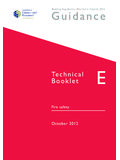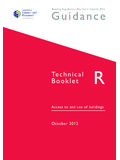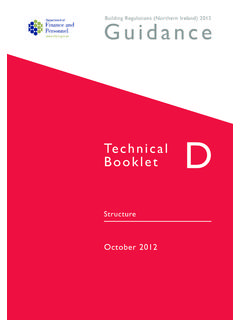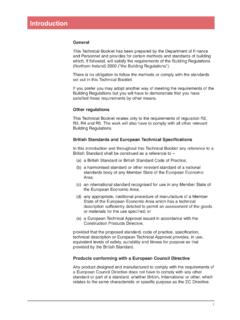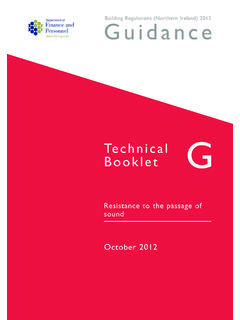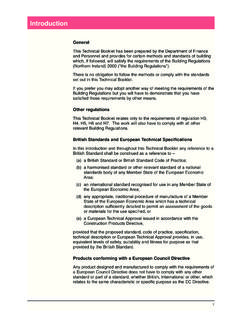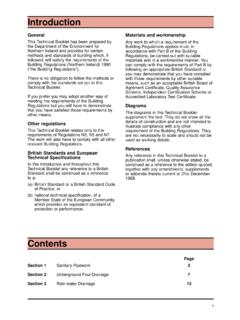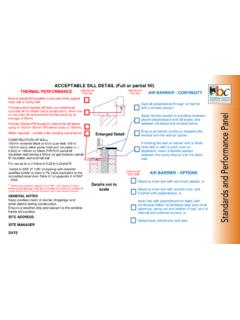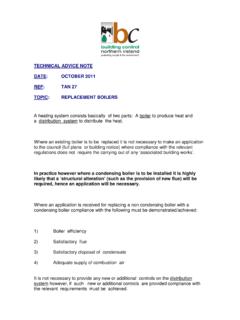Transcription of Technical Booklet - Building Control NI
1 Guidance Department of Building Regulations (Northern Ireland) 2012. Finance and Personnel Te c h n i c a l Booklet H. Stairs, ramps, guarding and protection from impact October 2012. Contents page Introduction Technical Booklets 3. This Technical Booklet 3. Protected buildings 4. Other legislation 4. Part H Regulations 6. Guidance Performance and introduction to provisions Stairs, ladders, ramps and their landings 9. Guarding 10. Vehicle loading bays 10. Protection against impact from and trapping by doors 11.
2 Protection from collision with open windows, skylights or ventilators 11. Section 1 General Definitions 12. Visual contrast 13. Section 2 Access routes to buildings General 14. Ramps and complementary steps on access routes to buildings other than dwellings 15. Ramped approach 15. Ramped approach with complementary steps 15. Ramps and steps on access routes to dwellings 19. Section 3 Stairs Common provisions for all stairs 21. Additional provisions for private stairs and common stairs in blocks of dwellings 25.
3 Additional provisions for stairs in buildings other than dwellings 30. Spiral or helical stairs in dwellings 33. Technical Booklet H: 2012 Stairs, ramps, guarding and protection from impact 1. Stairs and fixed ladders providing access for maintenance 33. Section 4 Ramps in buildings Ramps in dwellings 34. Ramps within common areas of a block of dwellings 35. Ramps in buildings other than dwellings 36. Section 5 Guarding General 39. Guarding of spiral or helical stairs in a dwelling 41. Stair or fixed ladders 41.
4 Vehicle barriers 41. Section 6 Vehicle loading bays Loading bays 42. Section 7 Protection against impact from and trapping by doors Doors and gates 43. Section 8 Protection from collision with open windows, skylights or ventilators General 44. Appendix Publications referred to 45. 2 Stairs, ramps, guarding and protection from impact Technical Booklet H: 2012. Introduction Technical Booklets This Technical Booklet , which takes effect on 31st October 2012, is one of a series that has been prepared by the Department of Finance and Personnel (the Department) for the purpose of providing practical guidance with respect to the Technical requirements of the Building Regulations (Northern Ireland) 2012 (the Building Regulations).
5 At the back of each Technical Booklet is a list of all the Technical Booklets that have been prepared and published by the Department for this purpose. The guidance given in a Technical Booklet includes performance standards and design provisions relating to compliance with specific aspects of the Building Regulations for the more common Building situations. If the guidance in a Technical Booklet is followed there will be a presumption of compliance with the requirements of those Building Regulations covered by that guidance.
6 However, this presumption can be overturned, so simply following the guidance does not guarantee compliance. For example, if a particular circumstance is not one of the more common Building situations the design provisions given in the Technical Booklet may not be appropriate. There are likely to be alternative ways of demonstrating compliance with the relevant requirements of the Building Regulations other than by following a design provision given in a Technical Booklet . There is therefore no obligation to adopt any particular provision set out in a Technical Booklet , should you decide to comply in some other way.
7 However, you will have to demonstrate that your alternative solution meets the relevant requirements of the Building Regulations by those other means. This Technical Booklet Requirements The guidance contained in this Technical Booklet relates only to the requirements of regulations 56, 57, 58, 59 and 60. The work will also have to comply with all other relevant requirements of the Building Regulations. Materials and workmanship Any Building work which is subject to requirements imposed by Part A of the Building Regulations should be carried out in accordance with regulation 23.
8 Of those regulations. Guidance on meeting these requirements for materials and workmanship is given in Technical Booklet B which supports Part B. Technical Booklet H: 2012 Stairs, ramps, guarding and protection from impact 3. The Building Regulations are made for specific purposes, primarily securing the health, safety, welfare and convenience of people and for the conservation of fuel and power. Standards and Technical approvals are relevant guidance to the extent that they relate to these purposes.
9 However, they may also address other aspects of performance such as serviceability, or aspects which although they relate to health and safety are not covered by the Building Regulations. Named standards Where this Technical Booklet makes reference to a named standard, the relevant version of the standard is the one listed in the Appendix. However, if this version has been replaced or updated by the issuing standards body, the new version may be used as a source of guidance provided that it continues to address the relevant requirements of the Building Regulations.
10 Diagrams The diagrams in this Technical Booklet supplement the text. They do not show all the details of construction and are not intended to illustrate compliance with any other requirement of the Building Regulations. They are not necessarily to scale and should not be used as working details. Protected buildings District councils have a duty to take account of the desirability to preserve the character of protected buildings when carrying out their functions under Building Regulations. Therefore, where work is to be carried out to a protected Building to comply with Part H or any other Part of the Building Regulations, special consideration may be given to the extent of such work for compliance where it would unacceptably alter the character or appearance of the Building .
